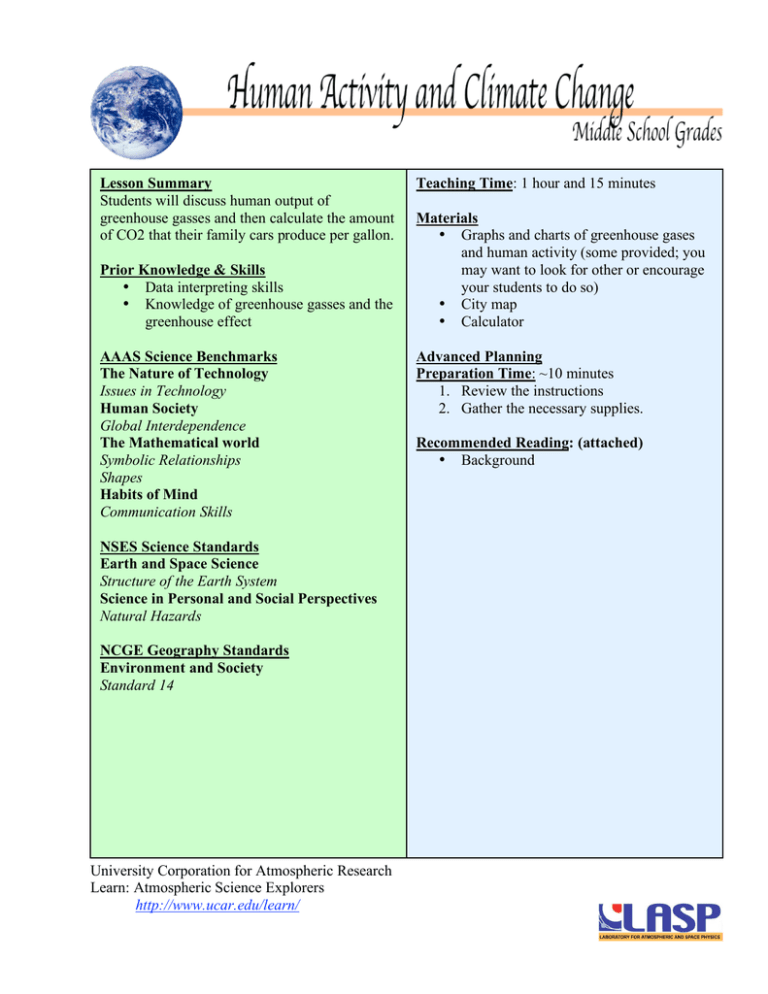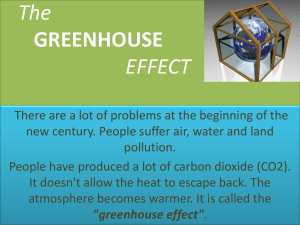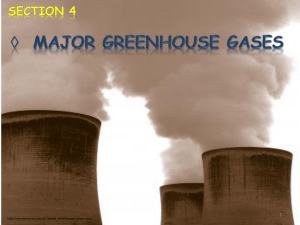Students will discuss human output of
advertisement

Lesson Summary Students will discuss human output of greenhouse gasses and then calculate the amount of CO2 that their family cars produce per gallon. Prior Knowledge & Skills • Data interpreting skills • Knowledge of greenhouse gasses and the greenhouse effect AAAS Science Benchmarks The Nature of Technology Issues in Technology Human Society Global Interdependence The Mathematical world Symbolic Relationships Shapes Habits of Mind Communication Skills NSES Science Standards Earth and Space Science Structure of the Earth System Science in Personal and Social Perspectives Natural Hazards NCGE Geography Standards Environment and Society Standard 14 University Corporation for Atmospheric Research Learn: Atmospheric Science Explorers http://www.ucar.edu/learn/ Teaching Time: 1 hour and 15 minutes Materials • Graphs and charts of greenhouse gases and human activity (some provided; you may want to look for other or encourage your students to do so) • City map • Calculator Advanced Planning Preparation Time: ~10 minutes 1. Review the instructions 2. Gather the necessary supplies. Recommended Reading: (attached) • Background Activity 20 Teacher Guide: Human Activity and Climate Change Human Activity and Climate Change Modified with permission from Global Climates - Past, Present, and Future, S. Henderson, S. Holman, and L. Mortensen (Eds.), EPA Report No. EPA/600/R-93/126. U.S. Environmental Protection Agency, Office of Research and Development, Washington, DC., pp. 91 - 94. In this activity, students will examine graphs of GHG emissions and their increases associated with human activity. They will focus on , , , CFCs, and . Students will calculate some personal contributions to emissions. If you have been using other activities from the Global Climate Change section of this Web site, you may find this activity is a good culmination to determine if students have absorbed enough to discuss the issue and connect it to what they do. Background Most scientists believe that human activity is altering the composition of the atmosphere by increasing the concentration of greenhouse gases (GHGs). Greenhouse gases occur naturally in the atmosphere and their presence results in what atmospheric scientists call the greenhouse effect. It is important to remember that the greenhouse effect is what keeps the earth warm enough to be habitable. The current concern is directed at an enhanced greenhouse effect, one that would put more heat-absorbing gases into the atmosphere, thereby increasing global temperatures. The enhanced greenhouse effect has been linked to increased GHG emissions from human activities. Nitrogen (78%) and oxygen (21%) constitute 99% of the dry atmosphere. The rest of the gases, including GHGs, are collectively classified as "trace" gases due to their low concentrations. http://www.ucar.edu/learn/1_4_2_20t.htm (1 of 9) [7/25/07 2:23:06 PM] Activity 20 Teacher Guide: Human Activity and Climate Change The recent attention given to the greenhouse effect and global warming is based on the recorded increases in concentrations of some of the greenhouse gases due to human activity. Of particular interest are water vapor, carbon dioxide, methane, nitrous oxide, chlorofluorocarbons, and ozone. With the exception of chlorofluorocarbons, all of these gases occur naturally and are also produced by human activity. Water vapor is the most important GHG on the planet. Unlike most of the other atmospheric gases, water vapor is considered to be a 'variable' gas; that is, the percentage of water vapor in the atmosphere can vary greatly depending on the location and source of the air. For example, over the tropical oceans, water vapor may account for 4% of the total volume of gases, while over deserts or at high altitudes, it may be nearly absent. Water vapor absorbs heat readily. When discussing gobal warming, however, people often don't consider water vapor. Why not? The main reason is that human activity is not directly changing water vapor content. However, we do directly influence other GHGs. Although other GHGs are individually less important than water vapor, increasing their concentrations may affect global climate in significant and measurable ways. ) is considered the most important human-influenced GHG. Carbon dioxide ( Scientific measurements reveal an unmistakable global increase that is rapid and escalating. This increase arises primarily from the burning of fossil fuels (motorized vehicles, electric power plants, and homes heated with gas or oil) and the burning and clearing of forested land for agricultural purposes. ) is largely a product of natural biologic processes, but its output can be accelerated Methane ( is emitted from the decay of organic matter in waterlogged soils (for by human activities. example, wetlands and rice paddies) and from the digestive tracts of grazing animals (for example, ruminants). The additions from human activities include the expansion of rice agriculture, the increased number of livestock, the increased number of landfills, and leakage from natural gas pipelines. Chlorofluorocarbons (CFCs) have no natural source; they are produced entirely by human activity. CFCs have historically been used widely as refrigerants in air conditioners, refrigerators, freezers, and heat pumps. They are found in some foam plastics and used in some electronics manufacturing. Even though CFC production has been vastly reduced, these compounds remain in the atmosphere for a long time; we shall see their effects as GHGs for many years. http://www.ucar.edu/learn/1_4_2_20t.htm (2 of 9) [7/25/07 2:23:06 PM] Activity 20 Teacher Guide: Human Activity and Climate Change Nitrous oxide ( ) is a naturally occurring GHG, which has increased significantly in recent years due to human activity. is emitted from coal-burning power plants and can be released from the breakdown of chemical fertilizers in the soil. Ozone ( ) is also a greenhouse gas. It is important not to confuse the presence of the ozone in the stratosphere (a good thing) with the presence of ozone in the troposphere (a bad thing). In the troposphere, ozone can be a major component of urban smog − damaging crops and aggravating respiratory problems as well as enhancing the greenhouse effect. The concentrations of these GHG are increasing (although, thanks to recent global agreements, CFCs are being largely eliminated and their concentrations have begun to drop in the lower atmosphere). The emissions are not uniformly distributed globally. Most of the emissions come from the more developed countries, where power generation, power consumption, and living standards are highest. In this activity, students will examine graphs of GHG emissions and their increases associated , , , CFCs, and . Students will calculate with human activity. They will focus on some personal contributions to emissions. Learning Goals 1. Students will be able to identify sources of the major greenhouse gases and identify the current trends in atmospheric concentrations. 2. Students will be able to calculate greenhouse gas emissions on personal and larger scales. Alignment to National Standards National Science Education Standards ● Life Science, The Interdependence of Organisms, Grades 9 to 12, pg. 186, Item #5: "Human beings live within the world's ecosystems. Increasingly, humans modify ecosystems as a result of http://www.ucar.edu/learn/1_4_2_20t.htm (3 of 9) [7/25/07 2:23:06 PM] Activity 20 Teacher Guide: Human Activity and Climate Change population growth, technology, and consumption. Human destruction of habitats through direct harvesting, pollution, atmospheric changes, and other factors is threatening current global stability, and if not addressed, ecosystems will be irreversibly affected." Benchmarks for Science Literacy, Project 2061, AAAS ● ● The Physical Setting, Processes That Shape The Earth, Grades 6 to 8, pg. 73, Item #7: "Human activities, such as reducing the amount of forest cover, increasing the amount and variety of chemicals released into the atmosphere, and intensive farming, have changed the earth's land, oceans, and atmosphere. Some of these changes have decreased the capacity of the environment to support some life forms." The Living Environment, Interdependence of Life, Grades 9 to12, pg. 117, Item #3: "Human beings are part of earth's ecosystems. Human activities can, deliberately or inadvertently, alter the equilibrium in ecosystems. Grade Level/Time ● Grade level: 6 to 9 ● Time: ❍ Teacher introduction to human activities and GHG: 20 minutes ❍ Student activity: 40 minutes ❍ Student discussion: 15 minutes Materials ● ● Graphs and charts of greenhouse gases and human activity (some provided below; you may want to look for others or encourage your students to do so) City map http://www.ucar.edu/learn/1_4_2_20t.htm (4 of 9) [7/25/07 2:23:06 PM] Activity 20 Teacher Guide: Human Activity and Climate Change ● Calculator http://www.ucar.edu/learn/1_4_2_20t.htm (5 of 9) [7/25/07 2:23:06 PM] Activity 20 Teacher Guide: Human Activity and Climate Change Procedure 1. Brainstorm possible human sources of GHGs. Where do these gases come from? Are the sources common all over the world or are some areas larger sources than others? 2. Read and discuss the charts and graphs. How does the information support or contradict the ideas formed during the brainstorming session? 3. Encourage the students to compare the GHG graphs with other graphs (for example, global temperature and human population increases) during the same time span. Encourage them to come up with their own comparisons. What kinds of trends do they predict? Can seemingly upward trends be reversed? 4. Ask students to discuss global emissions of GHGs. For example, the United States has only a small percentage of the world's population but emits a disproportionate share of the global . China has a population of over a billion people. What would happen if China "developed" to the point where most families owned an automobile that emitted ? 5. Calculate the personal/family/class contribution of ❍ due to vehicle use: Using a city map (if necessary), have each student estimate the distance from their home to school in miles. http://www.ucar.edu/learn/1_4_2_20t.htm (6 of 9) [7/25/07 2:23:06 PM] Activity 20 Teacher Guide: Human Activity and Climate Change ❍ ❍ ❍ ❍ ❍ ❍ Have each student identify their type of family vehicle based on the types listed in the table below. Have each student calculate the amount of gas used weekly if they rode to and from school everyday in a private car. To do this: ■ Add up the total number of miles for 10 round trips to school (remember, each time they are dropped off at school, the driver has to drive home, so there are 2 round trips a day) ■ Divide the total by the miles per gallon to determine the gallons of gas burned ■ Multiply the ■ Example: If you live 4 miles from school, your car travels 16 miles per day to drop you off and pick you up, or 80 miles per week. At that mileage, a full-size car will burn 5 gallons of gas per week. Five gallons of gas will produce 100 pounds of every week. released per gallon Calculate the class total as if everyone rode to school in a private vehicle. Have students who ride the bus do the same calculations again, using the figures for the bus and dividing the total released by the approximate number of students that ride on the bus. Determine how many students walk or bike to school. They do not contribute additional to and from school. to get Now re-calculate the class total based on the type of transportation actually used by students. Compare the results. How much difference is there? Vehicle MPG Pounds per gallon Compact car 24 20 Full-size car 16 20 http://www.ucar.edu/learn/1_4_2_20t.htm (7 of 9) [7/25/07 2:23:06 PM] Activity 20 Teacher Guide: Human Activity and Climate Change *Buses add more Truck/Van 13 21 Bus 8 22* per gallon, but they carry more passengers, so be sure to consider contribution by passenger, not just vehicle. Assessment Ideas The disparity between population size and GHG emissions is large, but very difficult to address without altering the lifestyle of the highest GHG emitters, at least in the short term. emission common in the U. As a written (or oral) assignment, ask students to pick one source of S. and argue in support of a 50% reduction in emissions from that source. To do so, they must explain: ● The sources ● How they propose to achieve the reduction ● The impact of the reduction on American lifestyles and/or economy ● How the reduction might slow the build-up of GHGs Alternatively (or as a companion assignment), ask students to imagine that they live in a developing country. Have them argue that they should be allowed to continue to increase GHG emissions as they pursue a better material standard of living for their citizens. http://www.ucar.edu/learn/1_4_2_20t.htm (8 of 9) [7/25/07 2:23:06 PM] Activity 20 Teacher Guide: Human Activity and Climate Change Modifications for Alternative Learners ● English Language Limited students might have difficulty comparing GHG gas charts with other graphics (the connections may be a bit abstract in step 3). Teachers should be very clear and consistent in connecting one chart to another in terms of simple cause-and-effect relationships. http://www.ucar.edu/learn/1_4_2_20t.htm (9 of 9) [7/25/07 2:23:06 PM]







